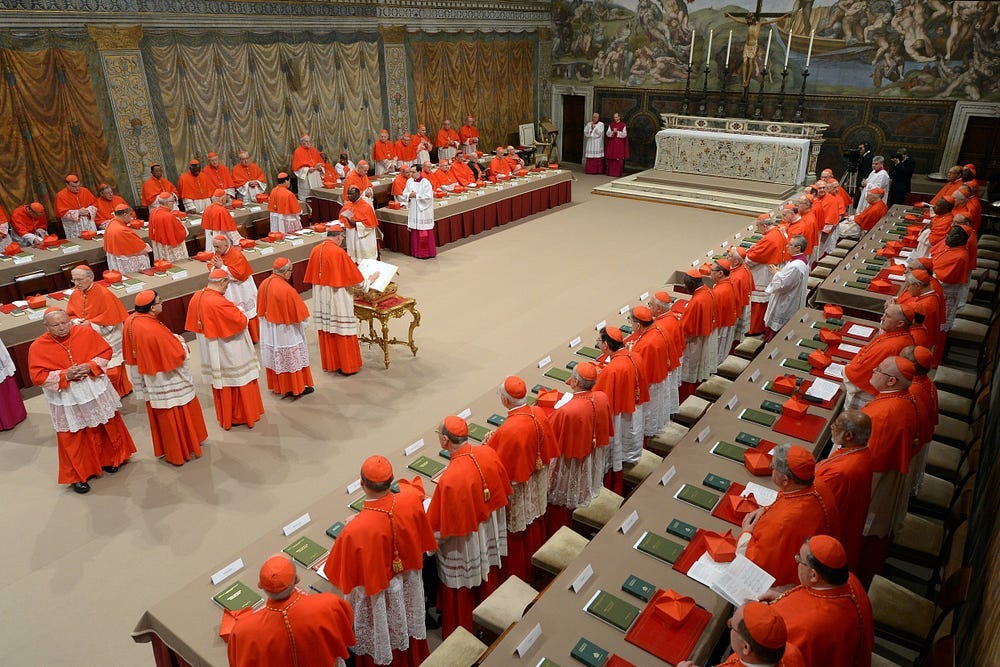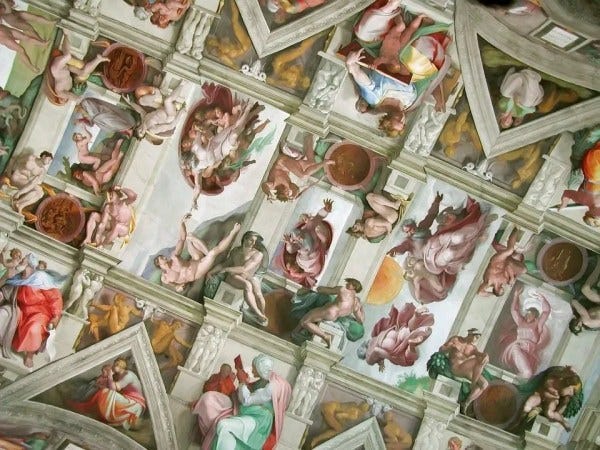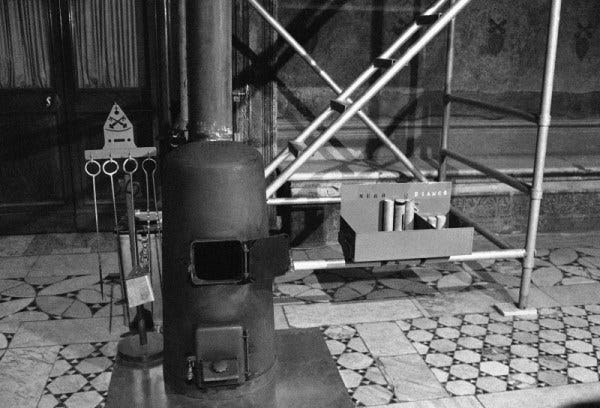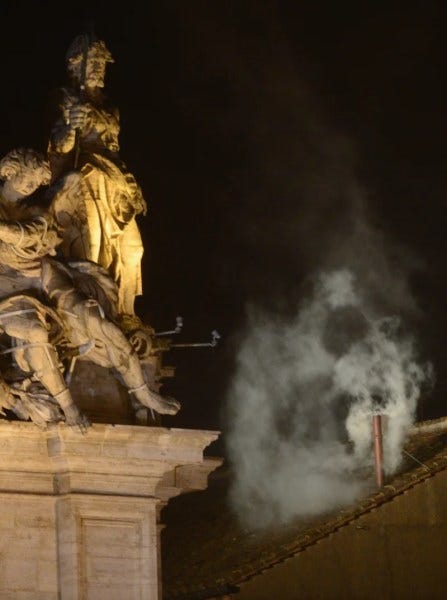
Today, May 7, is the beginning of the Conclave.
Most people, even knowledgeable Roman Catholics, are unfamiliar with the process of selecting a new pope. Much is shrouded in secrecy or obscured behind Latin and Italian terminology.
What happens when a pope dies? What is the significance of a pope? Who are the people responsible for electing a new pope? When and where does it happen? What happens during the election? What happens afterward?
What is Sede Vacante?
When a pope dies, the chair of leadership in the Roman Catholic church is empty. Sede is Latin for “seat” or “chair,” referring to the Bishop’s chair. Vacante means vacant.
In this case, it means that after the death, or in rare cases, the resignation of a pope, the Holy See experiences a period when “the seat is vacant.”
What is the significance of the Pope?
Among the three major divisions of Christianity — Roman Catholic, Eastern Orthodox, and Protestant — the Roman Catholic Church has a single leader, the pope, who oversees the entire church worldwide.
The Eastern Orthodox Church has the Ecumenical Patriarch of Constantinople, who is considered the archbishop and primus inter pares, or “first among equals,” among the autocephalous churches that comprise the Eastern Orthodox Church. The Greek word means “self-head” or independent of the authority of any other church.
The Protestant branch has no single head.
Differing Church Governments
This reflects differences in the history of various forms of church government. Most Protestant churches, particularly in the United States, operate under a congregational form of government, characterized by independent congregations and democratic governance. Exceptions would be Anglican, Episcopal, Lutheran, and Methodist churches, which have episcopal governments.
An “episcopal” form of church government involves a bishop (Greek: episcopos, meaning overseer) over a town or city. During the second and third centuries, bishops generally acted independently. Each bishop had the same responsibility and authority, with greater respect offered to those cities where one of the original Apostles lived or spent time. But Rome claimed both St. Peter and St. Paul. It was said that if you wanted a correct, biblically orthodox view of an issue, you went to the Bishop of Rome.
Roman Catholic Church Government
Over time, the Bishop of Rome came to be regarded as the bishop over all bishops. Roman Catholics refer to him as the “pope” (father). You may have heard the words Abba or “Abbot.” In the New Testament, Abba is a child’s affectionate name for “papa.” By the fifth century, it was applied to the Bishop of Rome.
He’s also referred to as the primate (first) or first bishop of Italy, and since 600, when Pope Gregory I (the Great) referred to himself as the “servant of the servants of God.”
The pope is also known as the supreme pontiff, or sometimes as Pontifex Maximus, at least since the death of the last Roman emperor, Constantine XI, in Constantinople in 1453. Pontifex means “bridge-builder.”
This term dates back to ancient Rome and refers to the high priest of the College of Pontiffs. During Republican Rome, the title was strictly a religious one, but with the rise of the Empire, Augustus adopted it, and emperors subsequently used it for at least three centuries.
Historical trivia:
While most people associate St. Peter’s Basilica in the Vatican as the seat of the pope, historically, and for most of the history of the church, it has been at the Archbasilica of St. John Lateran, the cathedral church of the Bishop of Rome. It is located in the city of Rome proper, 2.5 miles outside the Vatican. The adjacent Lateran Palace was the primary residence of the pope for a thousand years, from the 4th to the 14th century.
A cathedra, from the Greek, is a raised seat, or throne, of a bishop. Cathedral became synonymous with the seat or principal church of a bishopric. Roman Catholics believe the pope speaks authoritatively from this “chair.”
What is the role of the Camerlengo?
The camerlengo, or the pope’s “chamberlain,” ascertains the pope’s death and declares that he is dead, and the process for selecting a new pope begins. He assumes some of the pope’s administrative duties during the Interregnum.
What is the Interregnum?
The period “between the reigns” of the popes occurs following the pope’s death until the election of a successor. During this period, there is the papal funeral, mourning, and the beginning of the Conclave.
The open coffin remains at St Peter’s Basilica, where it lies in state for public viewings before the funeral.
At the first congregation of Cardinals in Rome, comprising some 60 members, a date was chosen for the funeral, 10:00 a.m. Rome time in St. Peter’s Square, on Saturday, April 26, 2025.
At Pope Francis’ request, he is buried at the Basilica of St. Mary Major in Rome rather than the traditional crypt below the altar of St. Peter’s in the Vatican.
What are the Novendiales?
On each of the “nine days” (Latin: novendiales) following the pope’s funeral, a cardinal previously chosen by the late pope presided over a Requiem Mass in St. Peter’s Basilica, associated with the official mourning period.
Where is the Conclave held?
The word Conclave comes from the latin cum clavis, meaning “with a key.” The cardinals enter the Sistine Chapel, where they are locked into the place of the papal election until it is concluded.

Built for Pope Sixtus IV (1471–1484), after whom it is named, this chapel was made famous by Pope Julius II (1503–1513) — played by Rex Harrison in the film The Agony and the Ecstacy — who in 1508 commissioned Michelangelo — played by Charlton Heston — to decorate its ceiling, a task he completed in 1512. Later, Michelangelo painted the “Last Judgment” on the altar wall for Pope Paul III (1534–1549).
Tourist Trivia:
A modern tour of the Vatican takes a visitor from the Vatican Museum to St. Peter’s Basilica. In between the two is the Sistine Chapel. As you enter the chamber and look up to see Michelangelo’s painting, there is an involuntary gasp of awe. When the gasp turns to comments and conversation, the din rises until the official “sush-er” encourages you to keep your voice down. Then, a few minutes later, he has to do it again.
Who participates in the Conclave?
The College of Cardinals called the Cardinal Electors to the Vatican. Cardinal is from the Latin cardo, meaning “hinge,” suggesting that, since the 4th century, their responsibility has been advising the pope.
To participate in the Conclave, they must be under 80 years old. Currently, there are 133 with voting privileges for the Conclave, the largest number ever.
Where do the Cardinal Electors stay?
The Cardinals reside in the Domus Sanctae Marthae, also known as “Saint Martha’s House,” a hotel-like facility located adjacent to St. Peter’s Basilica. Built under the direction of Pope John Paul II, it is named for Lazarus’ sister, Martha of Bethany, who took care of the needs of Jesus and the Disciples when they visited (Luke 10:38–41).
It is a guesthouse for visitors with business at the Vatican, particularly those attending the Conclave. Pope Francis chose to live there while serving rather than in the customary papal apartments of the Apostolic Palace.
Who Moderates the Conclave?
The Dean of the College of Cardinals presides over the initial mass. He moderates or facilitates the Conclave, leading the Cardinal Electors into the Sistine Chapel and singing hymns.
As the most senior member of the College of Cardinals, elected from the ranks of the Cardinal Bishops and confirmed by the pope, he also holds the titular office of Bishop of Ostia, the diocese at the mouth of the River Tiber that runs through Rome.
Extra omnes or “everyone else, out!” is declared, meaning anyone other than the Cardinal Electors must leave the Chapel. The doors are locked, and the Cardinals are in seclusion. The only communication that leaves the room is smoke.
What Happens at the Conclave?
The Conclave can begin as early as 15 days after the pope’s death, allowing all voting cardinals to attend. However, once a maximum of 20 days have passed, the cardinals are required to commence the Conclave.
In 1268, the College of Cardinals was unable to agree on a new pope for two years and eight months. The election was in the village of Viterbo in central Italy. The cardinals took so long that the townspeople locked them inside, fed them only bread and water, and even removed the roof of the Palazzo dei Papi di Viterbo, it was joked, “to let the Holy Spirit in.” The chosen individual was neither a cardinal nor a priest, but a crusader fighting in the Holy Lands. Eight months later, he returned and took the name Pope Gregory X, and subsequently ordered a formal Conclave to prevent long vacancies.
The Conclave begins today with the cardinals signing in Latin, an oath of “total secrecy” and seclusion, under threat of excommunication. Hence, some details of the Conclave remain shrouded in mystery.
How does the Voting proceed?

On the first evening of the Conclave, there is a single round of voting for the next pope. Subsequently, there are one or two rounds of ballots each morning and one or two more rounds in the afternoon.
After each ballot is counted, a needle is passed through it, and it is placed into a stove in the corner of the Sistine Chapel. Chemicals are added to indicate, via black smoke that passes out of the Vatican, that a two-thirds supermajority vote has not been achieved.
White smoke indicates that a new pope has been elected, and there is rejoicing outside the Sistine Chapel in St. Peter’s Square.
White smoke billows from a chimney at the Sistine Chapel, signaling that cardinal electors have chosen a new pope. Image: Jeff J Mitchell/Getty Images
In modern times, this process can take between two and four days.
What happens after there’s a Two-thirds Majority?
The newly elected pope is then asked two questions:
Do you accept?
What name do you choose?
This is often a name different from the name they were known by before.
Then, from the balcony over St. Peter’s Square, the proto-deacon, the most senior cardinal deacon, will announce:
Habemus Papam! We have a pope!
Bill Petro, your friendly neighborhood historian
billpetro.com
Subscribe to have future articles delivered to your email. If you enjoyed this article, please consider leaving a comment.




